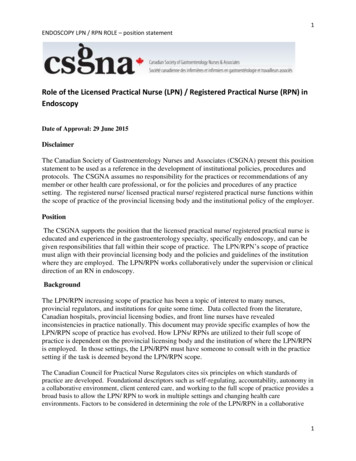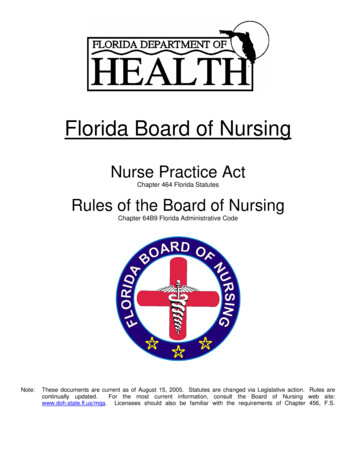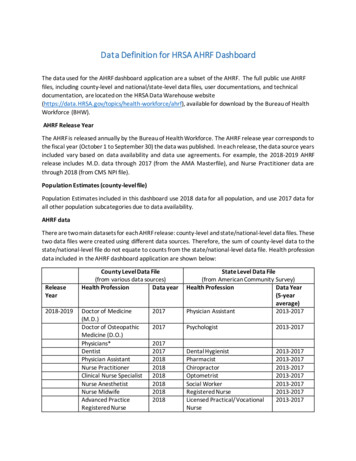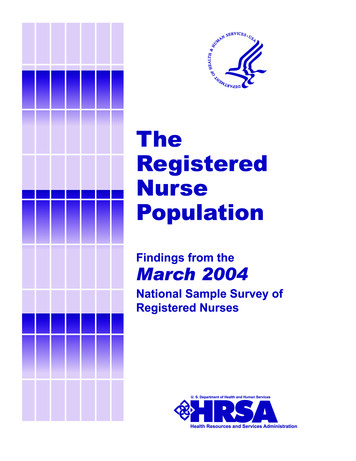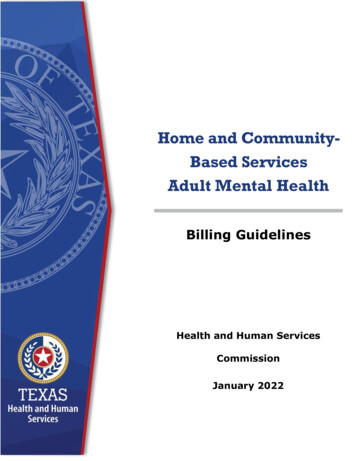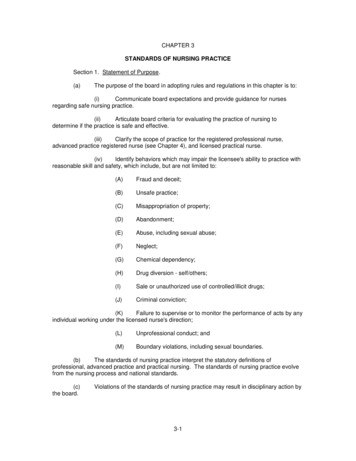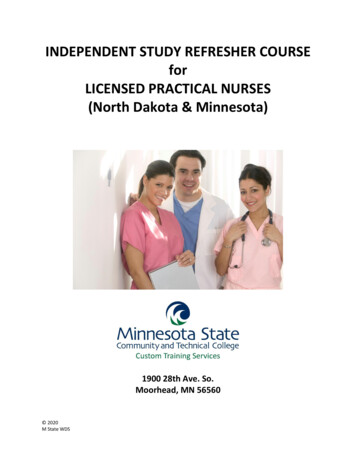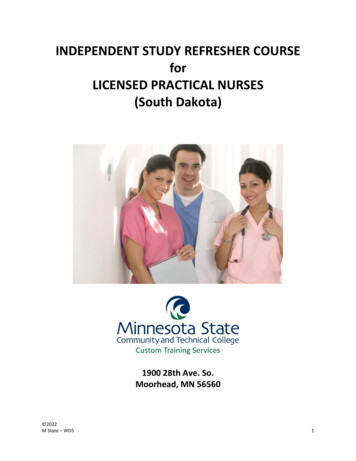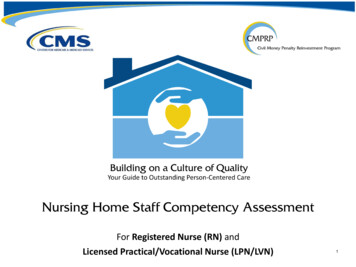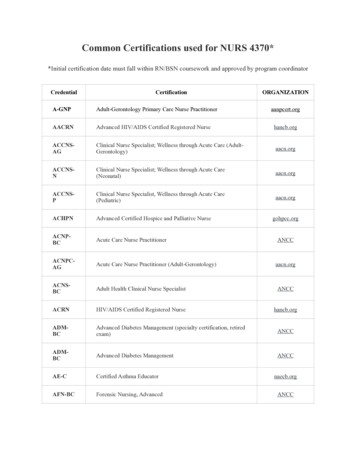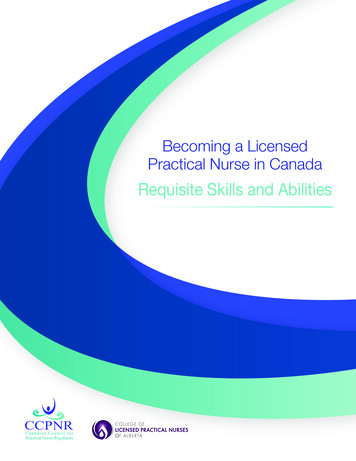
Transcription
Becoming a LicensedPractical Nurse in CanadaRequisite Skills and Abilities
ForewordThe Canadian Council for Practical Nurse Regulators (CCPNR) is a federation of provincial and territorialmembers who are identified in legislation, and responsible for the safety of the public through the regulation ofLicensed Practical Nurses (LPNs).The Council of the CCPNR recognized the need to develop the requisite skills and abilities for individuals to useto determine their ability to provide safe, competent and ethical nursing care, and meet the demands for a career asa LPN in Canada. A steering committee from the representatives of all jurisdictions who license and/or regulateLPNs across Canada (with the exception of Quebec) was identified to guide and advise the project. AssessmentStrategies Inc. was commissioned to research and develop the requisite skills and abilities in collaboration withthe steering committee. This document was validated by the LPN community and key stakeholder groups acrossCanada and was approved by the Boards of the respective regulatory authorities of the CCPNR’s Board members.This document is designed to identify the desired and achievable level of requisite skills and abilities expected ofLPNs and can provide direction in the development of policies and procedures in the practice environment. TheCCPNR thanks all participants who contributed to the creation of this document and acknowledges the College ofRegistered Nurses of British Columbia, the College of Registered Nurses of Manitoba, the College of RegisteredNurses of Nova Scotia and the College of Licensed Practical Nurses of British Columbia for the consultative useof their finalized or draft versions of their requisite skills and abilities documents in the creation of this document.The CCPNR approves and adopts the requisite skills and abilities for the LPN outlined in this document.For the purposes of this document, the term “licensed practical nurse” also refers to “registered practical nurse.”This document is only applicable in Canadian provinces or territories that have adopted or enacted these requisiteskills and abilities as regulatory requirements for practical nursing in that jurisdiction in accordance and consistentwith applicable law for that jurisdiction.The opinions and interpretations in this publication are those of the author and do notnecessarily reflect those of the Government of Canada.Available in French under the title:Devenir infirmier ou infirmière auxiliaire autorisé(e) au Canada - Compétences et aptitudes.This project is funded in part by the Government of Canada’s Foreign Credential Recognition Program.Copyright 2013 CCPNRAll rights reserved. The reproduction, storage in a retrieval system or transmission in any form or byany means (including electronic, mechanical, photographic, photocopying or recording) of any partof this publication without the prior written permission from CCPNR (Canadian Council for PracticalNurse Regulators) is an infringement of copyright law.For information contact CCPNR:Telephone: 709.579.3843 Fax: 709.579.3095 Email: chair@ccpnr.ca Website: www.ccpnr.ca2
Table of ContentsPREAMBLE. 4REGULATORY REQUIREMENTS. 5Cognitive . 5Communication . 6Interpersonal. 6Behavioural . . 6Sensory Perceptual . 7Physical . . 7Environmental . 8HUMAN RIGHTS CONSIDERATIONS. 8GLOSSARY. 9REFERENCES. 113
PreambleThe information in this document may be used by individuals to determine their ability to provide safe,competent and ethical nursing care, and meet the demands for a career as a licensed practical nurse inCanada.Canadians expect their health-care system to provide them with safe care and to support them inbecoming as healthy as possible. Meeting this expectation requires that licensed practical nurses areeducated and capable of providing safe, competent and ethical nursing care. They must demonstratethe capacity to meet jurisdictional entry-to-practice competencies, and be able to practise within thecontext of relevant legislation and regulation while adhering to professional standards of practice andcodes of ethics for the profession. Through legislation, the practical nursing profession is also grantedthe authority to recognize and set standards of education and standards of practice for the professionwith an obligation to protect and serve the public interest.The practice of licensed practical nurses spans a continuum from novice to expert and may encompassclinical practice, administration, education, research, consultation, management, regulation, policy andsystem development.Practical nursing is a profession that is practiced 24 hours a day, 7 days a week. Individuals must havethe ability to work various day/evening/night shift rotations, sometimes in excess of 12 continuoushours. Shifts occur on weekdays, weekends and holidays.Through their basic (entry-level) recognized education programs, experience and continuing educationactivities, licensed practical nurses gain the theoretical and practical foundation to provide safe,competent and ethical nursing care. Licensed practical nurses care for people of all ages, regardlessof gender, ethnicity or social situation, in a variety of practice settings (e.g., hospitals, communities,homes, clinics, schools and residential facilities). Their practice requires knowledge about health andillness, human biological sciences, the pathophysiology of diseases, health promotion and prevention,teaching and learning, and health-care systems.Licensed practical nurses have a duty to provide safe and appropriate nursing care and to practisecollaboratively with others members of the health-care team. They practise autonomously within theirown level of competence and seek guidance from other health-care professionals when aspects of thecare required are beyond their individual competence. The psychosocial components of care, includinginterpersonal, communication and teamwork skills, are fundamental to safe and effective practice.4
Regulatory RequirementsIndividuals who decide to pursue a career as a licensed practical nurse must meet certain formalrequirements for registration with the professional regulatory authority, including: successfully meeting the regulatory authority’s education and language requirements;demonstrating that they meet the entry-to-practice competencies;passing the Canadian Practical Nurse Registration Examination (CPNRE);demonstrating evidence of good character, including demonstrating that they possess the moraland ethical judgment expected of a licensed practical nurse;demonstrating the fitness to practice as a licensed practical nurse;demonstrating the cognitive, behavioural, communication, interpersonal and physical skills andabilities to engage in the practice of a licensed practical nurse; and,submitting a satisfactory criminal record review.Individuals with additional questions regarding these requirements should contact the educationprogram they wish to attend or the regulatory authority in the province/territory in which they wish topractise.Certain basic skills and abilities are required to practise as a licensed practical nurse in Canada. Therequisite skills and abilities provide the public and practitioners with information about the nature of theactivities that licensed practical nurses must be able to perform, and the general demands of practicalnursing education and practice.The requisite skills and abilities identified below are essential. They are organized into seven categoriesusing examples of entry-level practical nursing activities to illustrate the particular requirement. Thelist provides a snapshot of the nature and types of activities involved in typical entry-level licensedpractical nurse practice, but should not be considered exhaustive.CognitiveAbility to perform skills which demonstrate thinking capacity: Remember information; Able to focus on and manage multiple pieces of information at the same time; Able to problem solve, reason, make decisions and use critical thinking to develop professionaljudgment; and, Apply mathematical skills and abilities in order to:- Add, subtract, multiply and divide; and,- Calculate ratios and percentages, and apply algebraic equations.Example: The licensed practical nurse can recall clinical skills or patterns of signs andsymptoms and diagnoses from previous interactions, use past experiences to informcurrent decisions; perceive when situations require further inquiry; and recall written, oralor audio-taped information.5
CommunicationAbility to express and receive written, verbal and non-verbal language, and the ability to interact withothers in a respectful and professional manner: Speak, write, read and comprehend English and/or French adequately to effectivelycommunicate in a clear and concise manner; Recognize their own non-verbal signals and interpret those received from others whileconsidering individual differences in expression and associated meaning; and, Communicate information through documentation in client charts, both paper and electronic.Example: The licensed practical nurse can obtain and attend to information while takinga health history; and communicate well with other health-care team members.InterpersonalAbility to create positive relationships: Develop relationships and rapport with individuals and groups; Respond to the needs of clients and colleagues; Understand the differences between professional therapeutic relationships and personalfriendships; Work in close proximity to clients and colleagues; and, Understand that the LPN is providing care to a full range of individuals.Example: The licensed practical nurse can support a client during a painful procedureand identify that others have needs and perspectives that might differ.BehaviouralAbility to conduct oneself in a professional manner: Manage own behaviour to provide safe, competent and ethical nursing care; Admit to making mistakes; Engage in self-reflection; Take initiative to collaborate with others to create a safe environment; Respond appropriately in situations that are stressful or that involve conflict; React appropriately to giving and receiving physical touch; Fulfill responsibilities as part of a team; and, Set priorities and organize actions in an environment with multiple demands.Example: The licensed practical nurse can manage time appropriately. The licensedpractical nurse maintains a calm presence with clients, regardless of client behaviour.6
Sensory PerceptualAbility to accurately perceive with each of the following senses to provide safe care and activelyparticipate in nursing activities: Sight; Hearing; Smell; and, Touch.Example: The licensed practical nurse can read numbers and lines of demarcation on asyringe; feel a client’s pulse; and hear a client’s breath sounds.PhysicalAbility to perform and have control over each of the following actions to provide safe client care andto actively participate in educational activities: Stand and maintain balance; Possess manual dexterity; Move within limited spaces; Push and pull; Perform repetitive movements; Perform complex sequences of hand-eye coordination; Bend; Reach; Lift; Walk; Climb; and, Carry objects.Example: The licensed practical nurse can change a sterile dressing on a wound, prepareand administer medications by injection, assist an adult client to get out of bed and walk,perform cardiopulmonary resuscitation, and climb stairs for a home care visit while carryingsupplies that may weigh in excess of 8 kg.7
EnvironmentalAbility to function in the presence of each of the following commonly encountered and unavoidableenvironmental factors: Distractions; Unpredictable behaviour of others; Noxious odours; Disease agents; Noise; and, Chemicals.Example: The licensed practical nurse can tolerate and assess the odour of infections,urine, feces, sputum, blood and emesis.Anyone who has questions about whether or not they have the required skills and abilities for admissionto or progression through a recognized practical nursing education program, or entry into the licensedpractical nurse profession should contact the education program to which they intend to apply or theregulatory authority in the province/territory in which they wish to practice.Human Rights ConsiderationsHuman Rights legislation prohibits discrimination on a number of characteristics, including physicaland mental disabilities. Accommodation is the adjustment of a rule, practice, condition or requirementto take into account the specific needs of an individual or group with one or more of the protectedcharacteristics in, as may be applicable, provincial or territorial human rights legislation of the CanadianHuman Rights Act3. Reference would need to be made to the human rights legislation and law applicableto a particular province or territory to determine if and to what extent principles of accommodation mayapply to occupational standards for the practice of a licensed practical nurse.The purpose of this Act is to extend the laws in Canada to give effect, within the purview of matters coming withinthe legislative authority of Parliament, to the principle that all individuals should have an opportunity equal with otherindividuals to make for themselves the lives that they are able and wish to have and to have their needs accommodated,consistent with their duties and obligations as members of society, without being hindered in or prevented from doing soby discriminatory practices based on race, national or ethnic origin, colour, religion, age, sex, sexual orientation, maritalstatus, family status, disability or conviction for an offence for which a pardon has been granted. (Canadian HumanRights Act, 1987 R.S., 1985, c. H-6, s. 2; 1996, c. 14, s. 1; 1998, c. 9, s. 9.)38
GlossaryBelow are the terms and definitions as they are used in this document.ClientRefers to individuals (or their designated representatives), families and groups.Clinical judgmentProcesses that rely on critical inquiry to reflect the complex, intuitive and conscious thinkingstrategies that guide nursing decisions.CompetenceThe quality or ability of a practical nurse to integrate and apply the knowledge, skills, judgmentsand personal attributes required to practise safely and ethically in a designated role and setting.Personal attributes include, but are not limited to, attitudes, values and beliefs.CompetenciesThe integrated knowledge, skills, behaviours, attitudes, critical thinking and clinical judgmentexpected of an entry-level licensed practical nurse to provide safe, competent and ethical care.CompetentHaving or demonstrating the necessary knowledge, skills and judgments required to practisesafely and ethically in a designated role and setting.Continuing CompetenceThe ongoing ability to integrate and apply the knowledge, skills and judgement required topractise safely and ethically in a designated role and setting.Critical inquiryThis term expands on the meaning of critical thinking to encompass critical reflection onactions. Critical inquiry refers to a process of purposive thinking and reflective reasoning wherebypractitioners examine ideas, assumptions, principles, conclusions, beliefs and actions in thecontext of nursing practice. The critical inquiry process is associated with a spirit of inquiry,discernment, logical reasoning and application of standards. (Brunt, 2005; JurisdictionalCollaborative Process, 2006)Critical thinkingAn active and purposeful problem-solving process. It requires the practical nurse to advancebeyond the performance of skills and interventions to provide the best possible care, based onevidence-informed practice. It involves identifying and prioritizing risks and problems, clarifyingand challenging assumptions, using an organized approach to assessment, checking for accuracyand reliability of information, weighing evidence, recognizing inconsistencies, evaluatingconclusions and adapting thinking.Entry-level practitionerThe licensed practical nurse at the point of licensure, following graduation from an approvedpractical nursing program or equivalent.9
Evidence-informed practiceThe identification, evaluation and application of nursing experience and current research to guidepractice decisions.Fitness to practiseThe qualities and capabilities of licensed practical nurses relevant to their capacity to practise.This includes, but is not limited to, freedom from any cognitive, physical, psychological oremotional conditions, or a dependence on alcohol or drugs that impairs their ability to practisenursing.HealthA state of complete physical, mental, and social well-being and not merely the absence of diseaseor infirmity. It includes physical, mental, spiritual, emotional, psychological and social health.Health-care teamClients, families, health-care professionals, unregulated health workers, students, volunteers,educators, spiritual leaders and others who may be involved in providing care.Health promotionThe process of enabling people to increase control over and improve their health based on anunderstanding of the determinants of health. Health promotion is particularly concerned withvalues and vision of a preferred future.Legislated scope of practiceDetermined through provincial legislation set in individual jurisdictions.Professional regulatory authoritiesCanadian provincial and territorial professional bodies responsible for the regulation of licensedpractical nurses.Recognized education programAn education program recognized by the regulatory authorities in Canada as meeting theireducation requirements for licensed practical nurses.ResearchSystematic inquiry that uses orderly scientific methods and/or the nursing process to answerquestions or solve problems.SafetyThe reduction or mitigation of unsafe acts within the health-care team and health-care system.Scope of practiceThe parameters that outline the roles and responsibilities of the licensed practical nurse as definedby legislation and the regulatory authorities.Standards of practiceMinimum expected levels of practitioner behaviour, against which actual practitioner behaviour ismeasured.10
Unregulated health workerA health-care worker, who is not part of a regulated health profession, who provides care topersons under the guidance of a regulated health professional.ReferencesThe following competency requisite skills and abilities documents were consulted during thedevelopment of this document.College of Licensed Practical Nurses of British Columbia (DRAFT document– adapted withpermission from the College of Registered Nurses of British Columbia). Becoming a LicensedPractical Nurse in British Columbia: CLPNBC Requisite Skills and Abilities. Burnaby, BC:Author.College of Registered Nurses of British Columbia (2007). Becoming a Registered Nurse in BritishColumbia. Vancouver, BC: Author.College of Registered Nurses of Manitoba (2011). Requisite Skills and Abilities. Winnipeg, MB:Author.College of Registered Nurses of Nova Scotia (2009). Becoming a Registered Nurse in NovaScotia. Halifax, NS: Author.11
www.ccpnr.cawww.clpna.comJune 3, 2013 - CLPNA adopted the Canadian Council for Practical Nurse Regulator’s (CCPNR)“Standards of Practice for LPNs in Canada” and “Code of Ethics for LPNs in Canada” as the documentsrequired under the Health Professions Act.CLPNA also adopted the CCPNR’s “Entry to Practice Competencies for LPNs” and the “Becomingan LPN in Canada: Requisite Skills and Abilities” as guiding documents for the profession in Alberta.
The CCPNR approves and adopts the requisite skills and abilities for the LPN outlined in this document. For the purposes of this document, the term "licensed practical nurse" also refers to "registered practical nurse." This document is only applicable in Canadian provinces or territories that have adopted or enacted these requisite
